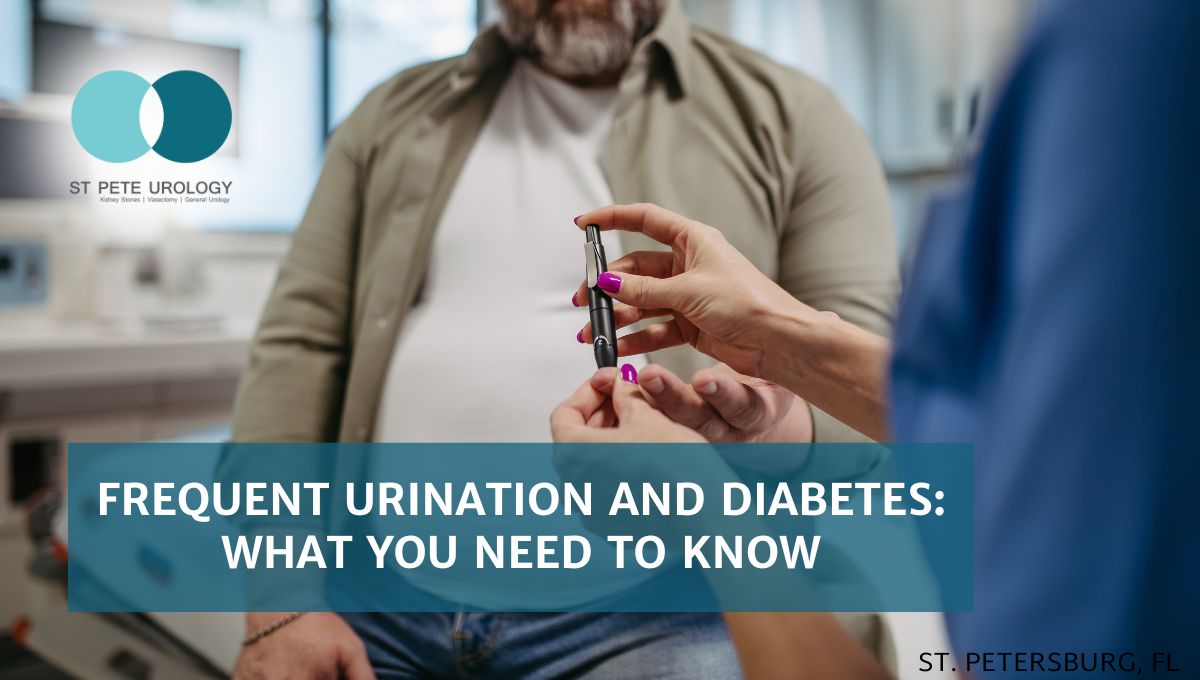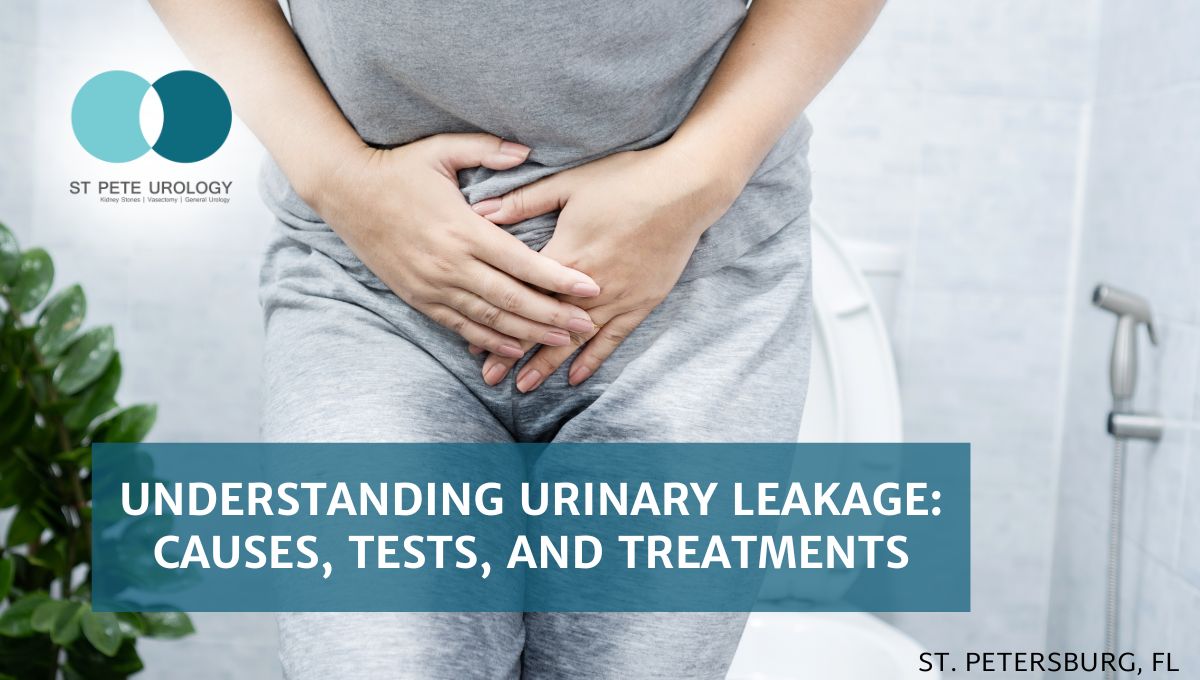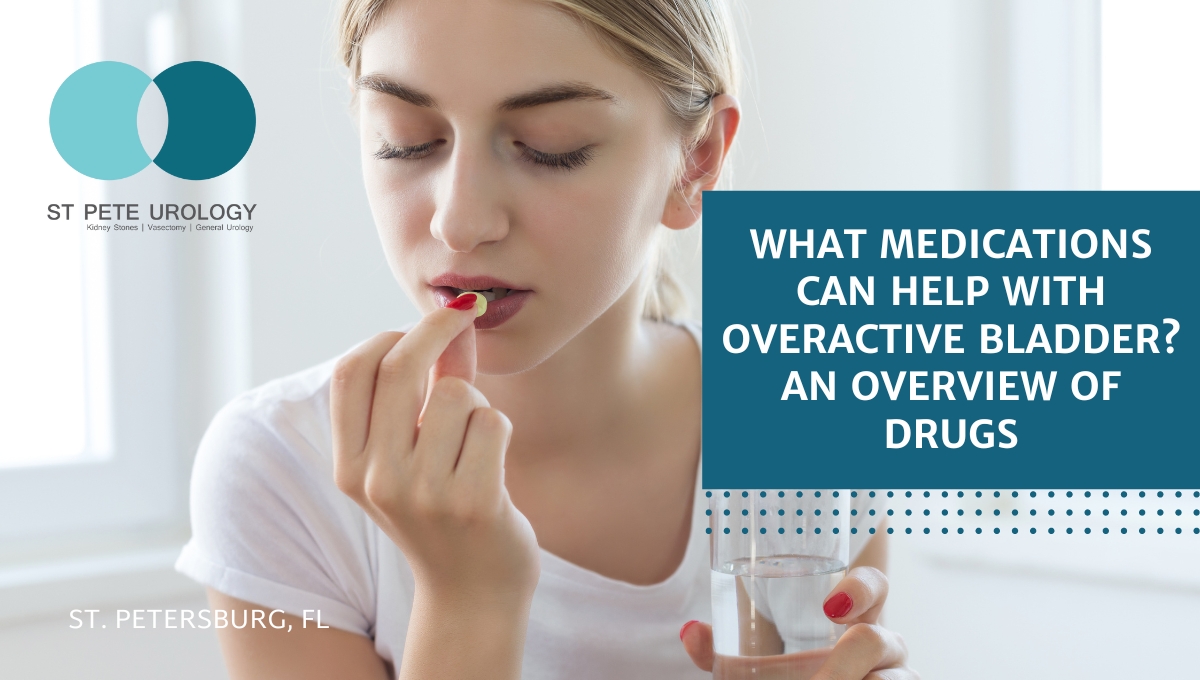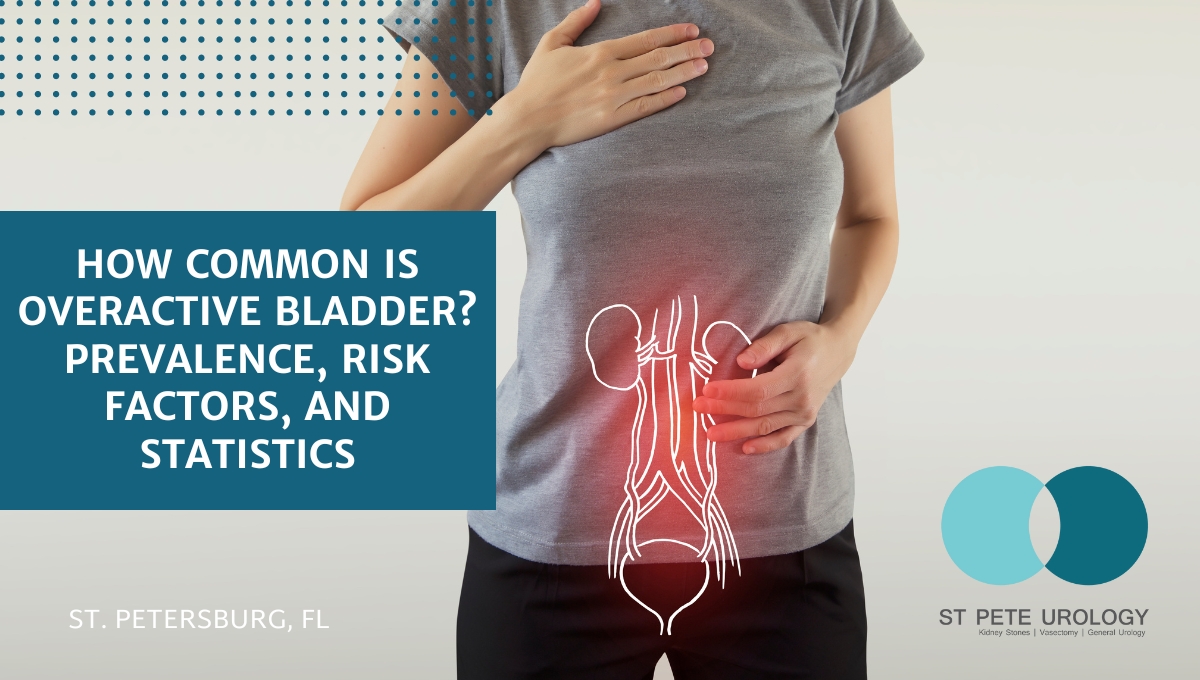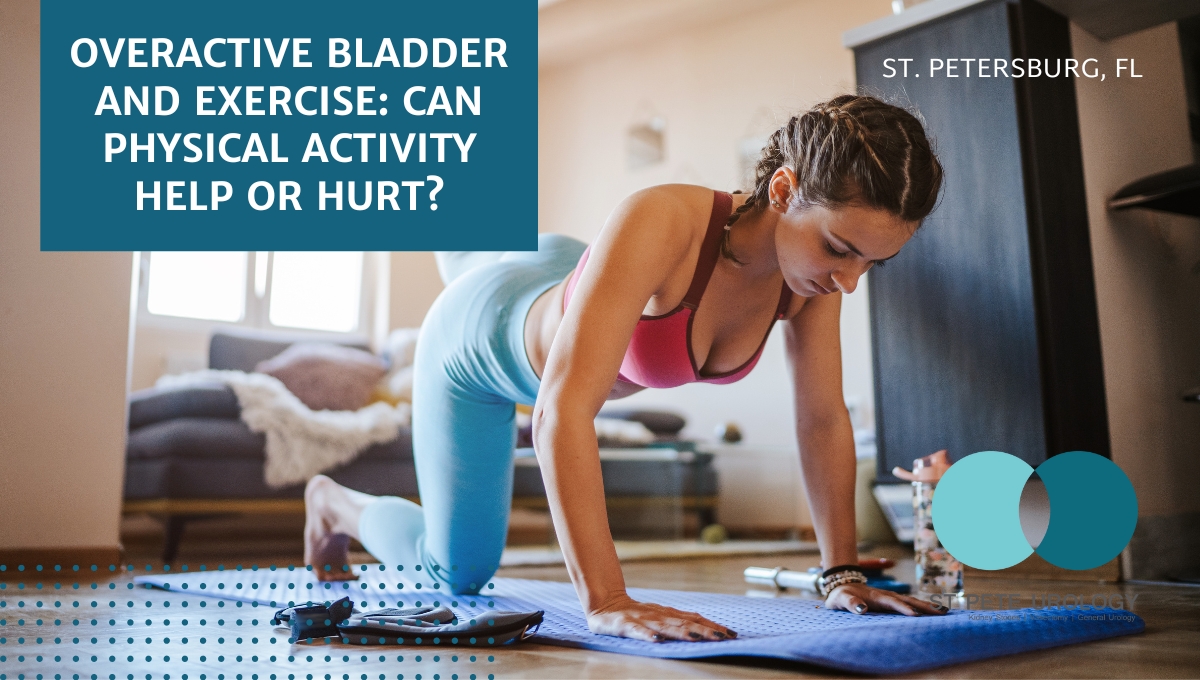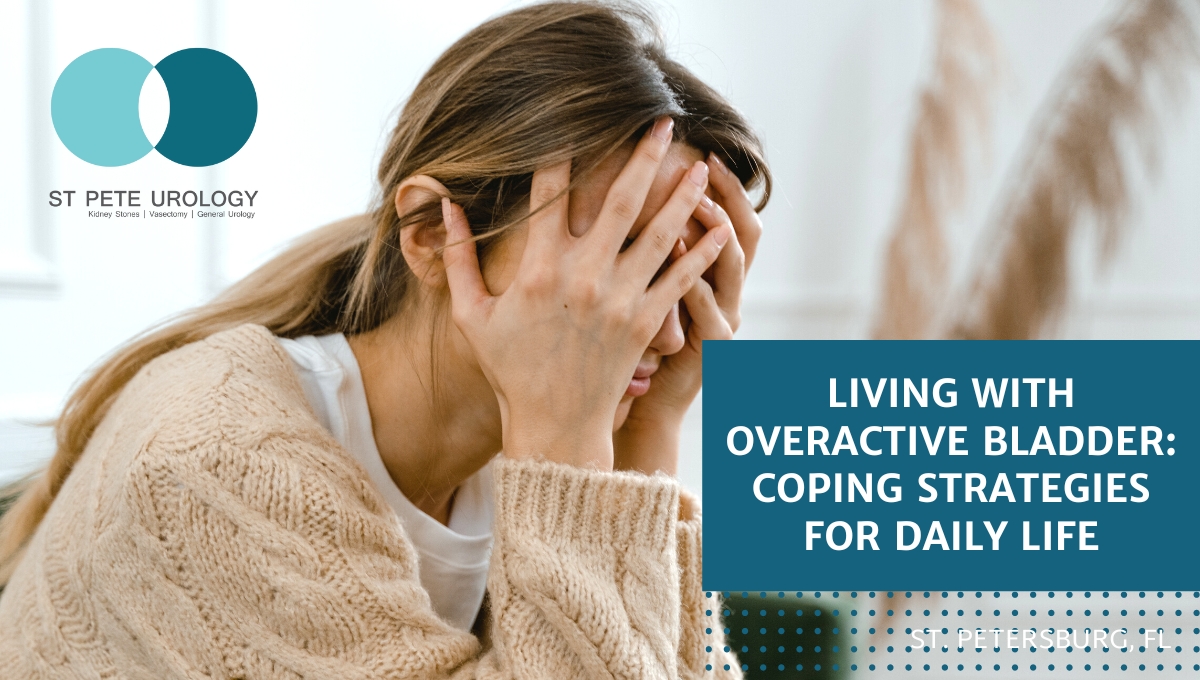Discover the connection between diabetes and urination problems, including frequent urination, incontinence, and UTIs. Expert urological care in St Petersburg.
Continue readingUnderstanding Urinary Leakage: Causes, Tests, and Treatments
Bladder leakage affects millions. Learn about causes from stress incontinence to overactive bladder, diagnostic tests, and proven treatments from St. Pete Urology.
Continue readingWhat Causes Incontinence
Dr. Nicholas Laryngakis discusses the factors on what causes incontinence and the complications and risks associated with the condition.
Continue readingWhat Does Your Urine Hue Say About Your Health?
Key Takeaways:
- Urine hue or color can be an indicator of health, with light yellow indicating good hydration and dark yellow or amber being a sign of dehydration or concentrated urine.
- Cloudy or milky urine can be a sign of urinary tract infection or kidney stones, while red or pink urine can be indicative of blood in the urine.
- Brown or dark-colored urine can be a sign of potential liver or kidney problems, and other factors like medications and diet can also influence the urine hue.
Have you ever considered how pivotal a role your urine plays as a diagnostic tool? Every day, your body performs countless actions behind the scenes, and one of them is the production of urine, which carries messages about your health status. This article aims to decode these telltale signs, unraveling an intimate connection between the hue of your urine and your wellbeing.
Understanding Urine Hue

Our exploration must start with an understanding of how urine gets its color. As your body processes water and nutrients, it simultaneously expels waste materials. Urobilins—waste substances—give urine its characteristic yellow color. The intensity of this color can vary, largely depending on your hydration level. Being well-hydrated typically yields a light yellow urine color—a sign of normal hydration and good health, like a badge of honor for the water-guzzlers among us.
Urine Color and Health Conditions
Dark yellow/amber urine color: Dehydration or concentrated urine
However, when your urine shifts to a dark yellow or amber color, it’s time to pay attention. This could be a sign of dehydration or concentrated urine. Chronic dehydration can lead to serious health risks, such as kidney stones or urinary tract infections. Ensuring to hydrate sufficiently—achieving that light yellow badge again—should be your first course of action.
Cloudy or milky urine color: Possible urinary tract infection (UTI) or kidney stones
Beyond this, a cloudy or milky hue could be indicative of a more concerning health issue—a potential urinary tract infection (UTI) or kidney stones. Such conditions can cause a significant alteration in urine color. If you notice this color shift, you should promptly seek a medical professional to get a proper diagnosis.
Red or pink urine color: Blood in the urine (hematuria)
Red or pink urine should set off your alarm bells—it can signal blood in the urine, a condition known as hematuria. Potential causes range from UTIs to kidney stones and even certain types of cancer. With such a wide spectrum of possibilities, promptly contacting a healthcare provider for further evaluation is paramount.
Brown or dark-colored urine: Potential liver or kidney problems
Meanwhile, a brown or dark-colored urine often signifies potential liver or kidney problems. Conditions like liver diseases or kidney disorders can lead to significant changes in urine color. Hence, if you observe such alterations, don’t hesitate to contact your healthcare provider to rule out these underlying conditions.
Other Factors Influencing Urine Color
Beyond health conditions, other factors like medications and your diet can influence the color of your urine. Certain prescription drugs, over-the-counter medicines, or supplements may alter your urine’s hue. Even some foods can temporarily change your urine color. For instance, beetroot might tint your urine pink or red, while asparagus can lend a greenish hue.
In conclusion, the color of your urine serves as a non-invasive health barometer. It’s an everyday diagnostic tool, and monitoring any changes in your urine color can provide early indications of potential health issues.
However, it is important to remember that while your urine can speak volumes, it doesn’t tell the complete story. Any concerns about urine color should prompt a visit to a healthcare professional for a proper diagnosis and treatment.
If you are in the St Petersburg, FL area and are seeking expert advice related to urine health or have any related symptoms, consider visiting St Pete Urology. With a team of experienced urologists, they are dedicated to providing comprehensive, top-quality care for the prevention, diagnosis, and treatment of urinary and urological disorders. Your urine color might be telling you something. Let the experts at St Pete Urology help you understand what it’s trying to say.
References:
- St Pete Urology. (2019, July 8). St. Pete Urology | Urologists in St Petersburg, Florida. St Pete Urology. https://stpeteurology.com/why-do-i-keep-getting-utis/
- Urobilin – American Chemical Society. (2021). American Chemical Society. https://www.acs.org/molecule-of-the-week/archive/u/urobilin.html
- Dehydration symptoms and treatments. (2020). NHSInform.scot. https://www.nhsinform.scot/illnesses-and-conditions/nutritional/dehydration
- and, D. (2023, August 14). Hematuria (Blood in the Urine). National Institute of Diabetes and Digestive and Kidney Diseases; NIDDK – National Institute of Diabetes and Digestive and Kidney Diseases. https://www.niddk.nih.gov/health-information/urologic-diseases/hematuria-blood-urine
How is Overactive Bladder Diagnosed? Tests and Exams You May Need
Key Takeaways:
1. OAB is a common bladder condition that affects over 200 million people globally, potentially impacting an individual’s quality of life.
2. Accurate diagnosis of OAB can be made through physical examination, bladder tests and imaging tests.
3. Treatment for OAB typically includes lifestyle changes, medications, and behavioral therapy. St Pete Urology is an excellent provider for diagnosis and treatment in the St. Petersburg area.
 Having a condition like an overactive bladder (OAB) can be a source of embarrassment and discomfort for an individual. Furthermore, this condition ranks among the most common bladder issues. Overactive Bladder (OAB) is characterized by a sudden and intense urge to urinate, often occurring more than 8 times a day and/or causing frequent awakenings during the night for urination (2 or more times per night). Globally, it impacts over 200 million people and can significantly disrupt one’s quality of life. In this article, we will elucidate the process of diagnosing OAB, outlining the necessary tests and examinations, available treatments, and emphasizing the importance of early diagnosis and intervention.
Having a condition like an overactive bladder (OAB) can be a source of embarrassment and discomfort for an individual. Furthermore, this condition ranks among the most common bladder issues. Overactive Bladder (OAB) is characterized by a sudden and intense urge to urinate, often occurring more than 8 times a day and/or causing frequent awakenings during the night for urination (2 or more times per night). Globally, it impacts over 200 million people and can significantly disrupt one’s quality of life. In this article, we will elucidate the process of diagnosing OAB, outlining the necessary tests and examinations, available treatments, and emphasizing the importance of early diagnosis and intervention.
Diagnosis of Overactive Bladder
The first step towards an accurate diagnosis of OAB is to make a thorough patient medical history to review prior medical history and possible underlying medical conditions that could be contributing to OAB. After an initial review, a physical examination is the next necessary step. The physical examination can provide important clues as to the possible causes of the OAB symptoms. After physical examination, bladder tests and imaging tests are the most common tests used to diagnose OAB with accurate precision.
Bladder Function Tests:
To better understand the individual’s bladder functionality, bladder function tests can be carried out. This includes urine flow tests and post-void residual (PVR) tests. Urine flow tests measure the flow rate of urine and the PVR tests measure how much urine is left in the bladder after urination. These tests give important information on the type of OAB and how it is being managed.
Imaging Tests:
Additionally, if other tests yield inconclusive results, healthcare providers may employ imaging tests to diagnose OAB. These tests have the capability to display images of the bladder and urinary tract, aiding in the identification of any underlying issues. These issues may include a blocked or narrowed urethra and abnormalities in bladder muscles or valves. Also, the presence of other underlying conditions like bladder stones or tumors.
Treatment of Overactive Bladder
Once an individual has been diagnosed with OAB, treatments to manage it can be initiated. These treatments are broken down into lifestyle changes, medications, and behavioral therapy.
Lifestyle Changes:
Making lifestyle changes is always the first step to managing OAB. Lifestyle includes reducing substance use, i.e. caffeine, alcohol or other stimulants, that can irritate the bladder. Limiting intake of fluids before bed, potential allergies to certain foods, managing stress, and increasing physical activity levels can also help to reduce pain and symptoms of OAB.
Medication:
If lifestyle changes don’t provide enough relief, medications are typically the second step in the treatment plan. Although these medications can help to reduce OAB symptoms, they can also produce unwanted side effects. Therefore, it is important to review all potential risks and side effects with your doctor before taking any medication.
Behavioral Therapy:
Behavioral therapy is another treatment type for OAB. This type of therapy is designed to help individuals gain better control of their bladders. The therapy helps to build awareness of the body’s signals when the bladders have reached a certain capacity and teaches individuals to delay or prevent urge responses.
Conclusion
Overactive bladder is a condition that affects many people and can cause significant discomfort and disruption to an individual’s daily activities. Accurate diagnosis of OAB can be made through physical examination, bladder tests and imaging tests. Once diagnosis is complete, treatment can begin. Treatments for OAB typically include lifestyle changes, medications, and behavioral therapy. Early diagnosis and treatment of OAB can help to reduce symptoms and improve quality of life.
St Pete Urology is a premier urology practice and leader in diagnosing and treating OAB in the St. Petersburg, Florida area. St Pete Urology’s dedicated team of highly experienced specialists and professional staff members work together to provide you with the best possible treatment so you can get back to living a life free from OAB symptoms and discomfort.
References:
- “Urodynamic Testing: What Is It, Procedure & What To Expect.” 17 Aug. 2020, https://my.clevelandclinic.org/health/diagnostics/15684-urodynamic-testing.
- “Overactive bladder (OAB) and lifestyle modification – Female Urology.” https://www.urineincontinence.com.au/overactive-bladder/overactive-bladder-oab-and-lifestyle-modification.
- “Diagnosing Overactive Bladder – WebMD.” 7 Jun. 2022, https://www.webmd.com/urinary-incontinence-oab/overactive-bladder-making-diagnosis.
What Medications Can Help with Overactive Bladder? An Overview of Drugs
Key Takeaways:
1. Overactive Bladder (OAB) is a common condition affecting millions of people across the United States.
2. Anticholinergics and mirabegron are the most common medications prescribed for OAB, but there are other medications available on a case-by-case basis.
3. St. Pete Urology provides comprehensive care for patients with OAB and other urological issues.
 Overactive bladder (OAB) is a common condition, affecting millions of people across the United States. It is characterized by a sudden, powerful urge to urinate, which may be accompanied by urinary incontinence. OAB can range from mild to severe and it can cause significant discomfort and disruption to daily activities. Fortunately, there are a variety of medications available to help manage the symptoms of OAB.
Overactive bladder (OAB) is a common condition, affecting millions of people across the United States. It is characterized by a sudden, powerful urge to urinate, which may be accompanied by urinary incontinence. OAB can range from mild to severe and it can cause significant discomfort and disruption to daily activities. Fortunately, there are a variety of medications available to help manage the symptoms of OAB.
I. Introduction
A. Definition of Overactive Bladder (OAB)
OAB is defined as a condition in which the bladder muscles contract involuntarily without warning. This makes it difficult for the person to control their urination. OAB can occur at any age, but it is more common in adults over the age of 40. Additionally, women are more likely to have OAB than men.
B. Describe Overview of OAB Symptoms
The primary symptoms of OAB include a sudden and frequent need to urinate, urinary urgency, and urinary incontinence. These symptoms can make it difficult to go about daily activities, such as going to work or school, exercising, and participating in social events. Other common symptoms of OAB include sleeplessness, difficulty concentrating, and irritability.
II. Symptoms and Diagnosis
A. Symptoms of OAB
The symptoms of OAB can vary from person to person, but the most common symptoms include a sudden and frequent need to urinate, urinary urgency, and urinary incontinence. Other symptoms may include difficulty sleeping, difficulty concentrating, and irritability.
B. Diagnosing OAB
If a person suspects they may be suffering from OAB, they should see their primary care physician or a specialist such as a urologist. The doctor may order a variety of tests, such as a urinalysis or bladder ultrasound, to determine if the person has OAB.
III. Treatment Options for OAB
A. Self-Care Measures for OAB
In many cases, self-care measures can help reduce the symptoms of OAB. These include increasing fluid intake, managing stress, avoiding certain foods and drinks that can irritate the bladder, avoiding alcohol, and using the bathroom regularly.
B. Medications for OAB
In some cases, medications may be prescribed to help manage the symptoms of OAB. These medications can be divided into two categories: anticholinergic medications and mirabegron.
1. Anticholinergic Medications
Anticholinergic medications are medications that work by blocking the action of a neurotransmitter called acetylcholine. This helps to relax the muscles of the bladder and reduce the urge to urinate.
2. Mirabegron
Mirabegron is a medication that is classified as a beta-3 agonist. It works by stimulating the bladder muscles, allowing them to hold more urine. This helps reduce the urge to urinate.
3. Other Medications
Other medications may be prescribed if the patient does not respond to anticholinergics or mirabergon. These medications are typically used on a case-by-case basis and may include antispasmodics, antidepressants, and alpha-blockers.
IV. Side Effects of OAB Medications
A. Anticholinergic Medications
Common side effects of anticholinergic medications include dry mouth, constipation, blurred vision, dizziness, and difficulty concentrating. These medications can also interfere with the absorption of certain vitamins and minerals from the gut.
B. Mirabegron
Common side effects of mirabegron include headache and flushing. These side effects usually resolve on their own, but if they persist you should speak to a healthcare provider.
V. Conclusion
A. Wrap Up Overall Information on OAB Medications
In conclusion, there are a variety of medications available to help manage the symptoms of OAB. Anticholinergic medications and mirabegron are the most commonly prescribed medications, but other medications may be used in certain cases. It is important to discuss all treatment options with a doctor and to be aware of any potential side effects or contraindications.
At St. Pete Urology, we provide comprehensive care for patients with bladder control problems and other urological issues. Our board-certified urologists and highly trained staff are prepared to help you take control of your bladder. We offer the latest treatment options and provide personalized, compassionate care. Contact us today to learn more about how we can help you manage your OAB symptoms.
References:
- “Overactive Bladder (OAB) in Women – Urology Associates.” https://www.denverurology.com/female-urology/oab/.
- “Anticholinergic Medications for Overactive Bladder – Healthline.” https://www.healthline.com/health/overactive-bladder/anticholinergic-medications.
- “Overactive Bladder | Polyuria – MedlinePlus.” 15 Sep. 2016, https://medlineplus.gov/overactivebladder.html.
How Common is Overactive Bladder? Prevalence, Risk Factors, and Statistics
3 Key Takeaways:
1. Overactive bladder (OAB) is a common urological condition characterized by frequent, urgent urination and disruption of day-to-day life.
2. Risk factors for developing OAB include age, gender, obesity and certain medications.
3. Early diagnosis and treatment for OAB can mitigate symptoms and improve quality of life, and St. Pete Urology can provide high-quality, individualized care for those suffering from OAB.
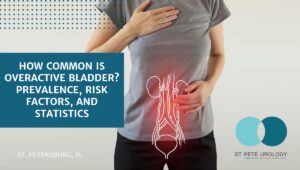 Overactive bladder (OAB) is a urological condition characterized by a sudden, uncontrollable, and frequent urge to urinate. People with OAB may find themselves unable to control their urge to urinate. This can cause issues with daily routines, social activities, emotional wellbeing, and ultimately lead to a decreased quality of life. This article will explore the prevalence, risk factors, and statistics associated with OAB.
Overactive bladder (OAB) is a urological condition characterized by a sudden, uncontrollable, and frequent urge to urinate. People with OAB may find themselves unable to control their urge to urinate. This can cause issues with daily routines, social activities, emotional wellbeing, and ultimately lead to a decreased quality of life. This article will explore the prevalence, risk factors, and statistics associated with OAB.
Prevalence of OAB
According to Statistic Brain, an estimated 183 million people suffer from OAB globally. Regionally, the prevalence of OAB is highest in North America, with an estimated 66.6 million people in the U.S. are currently experiencing OAB symptoms. The global and regional prevalence of OAB is largely influenced by a range of environmental and demographic factors. These factors include the aging population, rising global health awareness, sedentary lifestyle choices, and shifts in healthcare policies.
Risk Factors for OAB
There are a number of risk factors that may increase the likelihood of developing OAB. These include age, gender, obesity, urinary tract infections, strokes and other neurological diseases, diabetes, and certain medications. Studies have shown that women are more likely to experience OAB than men, with the risk increasing with age for both genders. Additionally, there is a strong correlation between obesity and OAB, with obese individuals having a higher risk of developing OAB.
Symptoms and Impact of OAB
The primary symptoms of OAB include frequent urge to urinate, urgent urination, frequent urination, and nocturia (nighttime urination). These symptoms can cause disruption in daily life, leading to difficulties with social activities, work, and maintaining relationships. Additionally, OAB can cause emotional and mental distress, leading to anxiety, embarrassment, and depression.
Diagnosis of OAB
OAB can be effectively diagnosed with a variety of tests and procedures, including physical examinations, urine tests, urine flow tests, and bladder scans. It is important to seek early diagnosis and treatment for OAB, as this can help minimize the disruption caused by the condition.
Treatment and Management of OAB
The treatment and management of OAB will depend on the individual patient, with a range of options available, including lifestyle changes, medications, bladder training, and physical therapy. It is important to discuss treatment options with a healthcare professional, as some medications may not be suitable for all patients. Additionally, lifestyle changes and self-management strategies can help to mitigate the symptoms of OAB and improve the quality of life.
Conclusion
Overactive bladder is a common urological condition characterized by frequent, urgent urination and disruption of day-to-day life. It is important to be aware of the prevalence, risk factors, and statistics associated with OAB. Key risk factors for developing OAB include age, gender, obesity, and certain medications. It is important to seek early diagnosis and treatment for OAB, as this can help to reduce the symptoms and improve the overall quality of life.
At St. Pete Urology, we strive to provide high-quality, individualized care for those suffering from common urological conditions such as overactive bladder. With our comprehensive and comprehensive approach, you can trust us to provide you with the most effective solutions for your OAB symptoms. Contact us today to schedule an appointment and get on the path to feeling your best!
References:
- “Incontinence Types & Risk Factors – Brigham and Women’s Hospital.” https://www.brighamandwomens.org/obgyn/urogynecology/types-of-incontinence-and-risk-factors.
- “Overactive bladder – Diagnosis and treatment – Mayo Clinic.” 3 May. 2022, https://www.mayoclinic.org/diseases-conditions/overactive-bladder/diagnosis-treatment/drc-20355721.
- “Urinary Incontinence risk factors – Hospital Clínic Barcelona.” 20 Feb. 2018, https://www.clinicbarcelona.org/en/assistance/diseases/urinary-incontinence/risk-factors.
Overactive Bladder and Exercise: Can Physical Activity Help or Hurt?
Key Takeaways:
1. Exercise can help to improve overactive bladder (OAB) symptoms, such as urgency and frequency of urination, involuntary leakage, and nocturia.
2. Low-impact aerobic exercise, strength training, and pelvic floor exercises can all be beneficial for people with OAB.
3. Before beginning a new exercise routine, it is important to speak with a doctor or specialist to determine the best type of exercises for the individual.
 Exercise is essential to maintaining good physical and mental health. Regular physical activity can reduce the risk of heart disease, diabetes, stroke, and mental health problems. Exercise can also improve bowel and bladder health, but this is not always the case. Overactive bladder (OAB) is a condition that causes the bladder to suddenly fill with urine, leading to urgency and leakage, which can make physical activity challenging or uncomfortable. This article will discuss the symptoms and effects of overactive bladder and explore how exercise can help or hurt this condition.
Exercise is essential to maintaining good physical and mental health. Regular physical activity can reduce the risk of heart disease, diabetes, stroke, and mental health problems. Exercise can also improve bowel and bladder health, but this is not always the case. Overactive bladder (OAB) is a condition that causes the bladder to suddenly fill with urine, leading to urgency and leakage, which can make physical activity challenging or uncomfortable. This article will discuss the symptoms and effects of overactive bladder and explore how exercise can help or hurt this condition.
Introduction
Overactive bladder is a condition that affects both men and women, but is more common in women, especially those over the age of 40. It is defined as urinary urgency and can include the involuntary leakage of urine. Often accompanied by an urge to urinate more often than normal and nighttime urination, OAB can cause disruption to one’s daily life. Despite its prevalence, OAB often goes undiagnosed; many people don’t recognize the signs and symptoms or don’t get the appropriate treatment.
Overview of Benefits of Regular Exercise
Exercise is important for so many different reasons, both physical and emotional, and it has a myriad of health benefits. Consistent and regular physical activity can lower your risk of heart disease, stroke, mental health problems, type 2 diabetes, and some forms of cancer. Additionally, exercise can help with control of bladder pressure and manage complications from OAB. Exercises that focus on the core and hip muscles, such as abdominal crunches, squats, and Pilates, can strengthen the pelvic floor muscles, help reduce incontinence episodes, and improve bladder control.
Symptoms of Overactive Bladder
The signs and symptoms of OAB vary from person to person. Some people may experience incomplete bladder emptying, frequent urination, urgency, or nighttime awakenings due to urges and leakage. Urinary incontinence is one of the most common signs of OAB, and is defined as any involuntary leakage of urine when one is not ready or able to control or prevent it. This can occur in a variety of forms, ranging from urge incontinence (leaking with the sudden urge to urinate) to fecal incontinence (leaking of stool). Urgency is another symptom of OAB, as it is a sudden and strong urge to urinate, often without warning or a sense of control. Nocturia (excessive night-time urination) is also common in people with OAB and can disrupt one’s sleep.
Types of Exercise to Help Overactive Bladder
There are many types of exercise that can help with OAB symptoms. Low-impact aerobic exercises such as swimming, walking, and cycling are beneficial for many reasons. They are low impact so they cause less stress on the joints and muscles, but still provide a good cardiovascular workout that strengthens and tones the entire body. Strength training is also important, as it helps to build strong muscles and can improve posture, balance, and core strength. Finally, there are pelvic floor (Kegel) exercises, which are specialized exercises designed to help strengthen the muscles of the pelvic floor, which can aid in improving urinary control.
Exercise Challenges Related to Overactive Bladder
Finding the right kind of physical activity can be challenging for some people with OAB. Traditional forms of exercise such as running, jumping, and high-impact aerobic activities can exacerbate OAB symptoms or make them worse. Additionally, the fear of leakage can make it difficult for individuals to feel comfortable engaging in physical activities. Finally, OAB can cause painful symptoms that can make physical activity more difficult or even unbearable.
Conclusion
Exercise is an important part of a healthy lifestyle, and it can be beneficial for people with overactive bladder. Low-impact aerobic exercise, strength training, and pelvic floor exercises can all help improve OAB symptoms such as urinary incontinence, urgency and frequency, and nocturia. However, finding the right kind of exercise can be challenging, and dealing with the fear of leakage or painful symptoms can make exercise even more difficult. It is important to find an exercise routine that works best for the individual.
Summary of Benefits of Exercise for Overactive Bladder
Regular physical activity can provide many health benefits, and it can be a great way to manage the symptoms of overactive bladder. Low-impact aerobic exercises, strength training, and pelvic floor exercises can all be beneficial for people with OAB. However, finding the right exercise routine may be challenging and dealing with the fears and painful symptoms can be difficult. It is important to speak with a doctor or specialist to determine the best type of exercise for each individual’s situation.
Closing Thoughts
Exercise can be a great way to manage and improve the symptoms of overactive bladder. However, it is important to speak with a doctor and/or specialist before beginning a new exercise program to ensure it is appropriate for your condition. If you live in the St. Petersburg area and are looking for help managing OAB symptoms through specialized exercises, St Pete Urology specializes in helping people with OAB find the right kind of exercise routine to improve their health.
References:
- “Focus on Fitness: Exercising With Bladder Problems – Today’s Dietitian.” https://www.todaysdietitian.com/newarchives/1118p56.shtml.
- “Urinary Incontinence: 4 Exercises For An Overactive Bladder.” 10 Sep. 2021, https://mytexashealthcareobgyn.com/well-woman-care/urinary-incontinence-4-exercises-for-an-overactive-bladder/.
- “What Is Overactive Bladder (OAB)?.” https://nafc.org/overactive-bladder/.
What Should You Eat with Overactive Bladder? Diet Tips and Foods to Avoid
3 Key Takeaways:
1. Eating foods high in fibre such as leafy greens, legumes, and whole grains can help improve OAB symptoms.
2. Staying hydrated by drinking enough water regularly can also help reduce OAB symptoms.
3. Exercising regularly can help strengthen the muscles in the bladder and improve OAB symptoms.
 Overactive bladder is a condition that affects many people, and the effects can be very uncomfortable. It is important to understand potential dietary causes for your OAB and learn about foods that you can eat to help improve your bladder health. In this article, we will discuss what an overactive bladder is, potential causes, diet tips, and foods to avoid to improve your bladder health.
Overactive bladder is a condition that affects many people, and the effects can be very uncomfortable. It is important to understand potential dietary causes for your OAB and learn about foods that you can eat to help improve your bladder health. In this article, we will discuss what an overactive bladder is, potential causes, diet tips, and foods to avoid to improve your bladder health.
What is an Overactive Bladder?
An overactive bladder (OAB) is a condition that affects the bladder by causing sudden, uncontrollable urges to urinate, even when your bladder is not full. These sudden urges can make everyday life uncomfortable and difficult, leading to embarrassment, and lack of time to get to a bathroom quickly. Common symptoms of overactive bladder include an urgent and frequent need to urinate, a feeling of not being able to hold onto the urine, and an increased need to “go” at night.
Potential Causes of Overactive Bladder
Your diet is one of the most influential factors in your bladder health. Certain nutrients in foods can have an influence on your urinary tract and bladder, including some minerals and vitamins. Additionally, certain foods may promote overactive bladder, including foods and drinks that are high in caffeine and artificial sweeteners. Furthermore, unhealthy eating habits, such as skipping meals and eating later in the day, may also play a role in the development of bladder issues.
To help improve OAB, it’s important to look at the foods and beverages you’re consuming and make changes to your diet. Here are some diet tips that may help improve your OAB.
Foods That Can Help Improve Overactive Bladder
To improve your overactive bladder, it’s important to focus on adding certain healthy goodies into your diet. Eating certain herbs and spices, such as turmeric and ginger, may help reduce inflammation in the bladder and provide relief of OAB symptoms. Fruits and vegetables, such as apples, bananas, and carrots, may also provide relief of symptoms. Additionally, including some whole grains in your diet, such as brown rice and oatmeal, may help improve OAB symptoms.
Changes in Diet and Lifestyle That Can Help Reduce Symptoms of Overactive Bladder
In addition to including more fruits and vegetables in your diet, adding fibre can also help improve OAB. Fibre soaks up water, which can help with controlling bladder urges. Eating foods high in fibre like leafy greens, legumes and whole grains can help with improving the OAB symptoms.
Drinking water is also key for controlling OAB symptoms. Staying hydrated throughout the day helps keep your body running, and in turn, helps regulate your bladder. Drinking enough water regularly can help reduce OAB symptoms.
Finally, getting regular exercise is important for improving OAB. Exercise helps strengthen the muscles in the bladder, which in turn may help to stop unwanted bladder urges. Getting regular physical activity can help improve OAB symptoms.
Conclusion:
In conclusion, diet and lifestyle modifications can be effective tools for improving overactive bladder. Eating a balanced diet full of fruits and vegetables, whole grains, and adding fibre to help with water absorption, can help reduce OAB symptoms. Also, drinking enough water to stay hydrated is key for controlling OAB, and getting regular exercise can help strengthen the muscles in the bladder.
At St Pete Urology, we understand how difficult and embarrassing an overactive bladder can be. Our team of experts can help provide advice and options for improving and managing your bladder issues. Contact us today to learn more about how we can help.
References:
- “Frequent Urination in Men and Women: Causes & Treatments.” 15 May. 2021, https://www.webmd.com/urinary-incontinence-oab/frequent-urination-causes-and-treatments.
- “Bladder control: Lifestyle strategies ease problems – Mayo Clinic.” https://www.mayoclinic.org/diseases-conditions/urinary-incontinence/in-depth/bladder-control-problem/art-20046597.
- “Overactive Bladder (OAB): Causes, Symptoms & Treatment.” 13 Sep. 2022, https://my.clevelandclinic.org/health/diseases/14248-overactive-bladder.
Living with Overactive Bladder: Coping Strategies for Daily Life
Key Takeaways:
1. Overactive bladder (OAB) is a condition with symptoms involving frequent urination, needing to use the bathroom urgently, and accidental leakage.
2. Treatments for OAB include medications, and behavioral modification techniques, such as bladder retraining, visualization techniques, and pelvic floor exercises.
3. Treating OAB can improve quality of life and reduce symptoms, leading to increased comfort and confidence.
Introduction
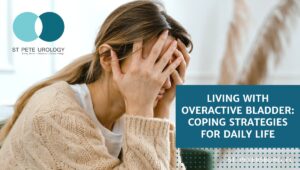 Overactive bladder (OAB) is a frequent cause of uncomfortable and even embarrassing symptoms in both men and women. It is a problem that affects an estimated 33 million Americans. Understanding OAB and knowing how to manage symptoms can help restore an individual’s quality of life.
Overactive bladder (OAB) is a frequent cause of uncomfortable and even embarrassing symptoms in both men and women. It is a problem that affects an estimated 33 million Americans. Understanding OAB and knowing how to manage symptoms can help restore an individual’s quality of life.
Definition of Overactive Bladder
Overactive bladder is a condition in which an individual experiences an urgent urge to urinate and sudden urge incontinence (accidental leaking). These symptoms can interfere with daily activities, work and sleep. Symptoms of OAB include:
• Frequent urination
• Needing to use the bathroom urgently
• Accidental leakage
• Psychological disruptions, such as anxiety and depression
Causes of Overactive Bladder
The cause of OAB is not known but it is believed to be related to a combination of a number of factors. Common causes of OAB include neurological conditions, obesity, diabetes, and urinary tract infections. There are a number of medications that can also cause OAB, such as diuretics and anti-depressants.
Treatment of Overactive Bladder
Treatment for OAB typically includes both medications and behavioral modification techniques. For some individuals, lifestyle changes such as a healthy diet or quitting smoking can be beneficial for managing symptoms. Other medications for OAB include bladder muscle relaxants, anti-muscarinic medications and topical estrogens.
In addition to medications, there are certain behavioral modification techniques used to help manage OAB. These techniques involve bladder retraining, which is done by gradually increasing or decreasing the time between voiding. This helps to teach your bladder to hold more comfortably and make it easier to control your urge incontinence. There are also natural remedies, such as relaxation techniques and herbal remedies, that can be used in the treatment of OAB.
Daily Strategies to Help Manage Overactive Bladder
Certain visualization techniques can help with managing your OAB symptoms. These techniques involve focusing on calming images or activities while you are experiencing urinary urgency. This can help you to focus on something else, instead of the urge to urinate.
Another helpful strategy is doing pelvic floor exercises, which can help to strengthen the bladder muscles. Strengthening these muscles can reduce the frequency and intensity of urinary urgency. There are also certain stress relief strategies that can be used, such as cognitive-behavioral therapy or yoga.
Outcomes of Addressing Overactive Bladder
Following a treatment plan for OAB can lead to significant improvements in quality of life. People with OAB often experience improved comfort and ability to control their bladder more effectively.
It can also increase an individual’s confidence, knowing that they can better manage their symptoms and reduce the risk of accidental leakage. Following a treatment plan leads to significantly reduced symptoms, such as decreased frequency of urination and decreased urge incontinence.
Conclusion
Having an overactive bladder can be uncomfortable, inconvenient and embarrassing. Fortunately, there are a number of treatments available for OAB, including both medications and behavioral modification techniques. Knowing how to manage OAB can help restore an individual’s quality of life. It can significantly reduce symptoms, increase comfort, and help individuals to regain their confidence.
St Pete Urology is a urology practice located in St Petersburg, Florida that specializes in the treatment of OAB. They provide comprehensive care for individuals with OAB and can help you to find the best treatment for your individual needs. From diagnosis and treatment to lifestyle adjustments, St Pete Urology can help you to manage your OAB symptoms.
References:
- “What Is Overactive Bladder? Symptoms, Causes, Diagnosis ….” 7 Feb. 2023, https://www.everydayhealth.com/overactive-bladder/.
- “Overactive Bladder Treatment & Management – Medscape Reference.” 20 Dec. 2022, https://emedicine.medscape.com/article/459340-treatment.
- “What Is Overactive Bladder (OAB)?.” https://nafc.org/overactive-bladder/.

